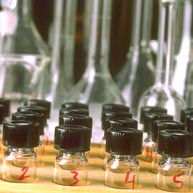Biotechnology Examples
Crop Breeding
Benefits of
Biotechnology
Safety of
Biotechnology

Traditionally, breeding this has been done by techniques such as selection, cross-pollination, grafting and so on. In the past two decades or so, scientists have found more direct ways to influence the genetics of plants and animals by inserting specific DNA fragments directly into the plants genes. This is called "Genetic Engineering".
Biotechnology Examples
There are many examples of biotechnology to draw from. First consider a natural insecticide, produced by a bacterium such as Bacterium thuringiensis, can be engineered into plants to protect them. The DNA fragment from the bacterium which makes the protein insecticide is inserted into the plant DNA. This protein is then manufactured by the plant and is harmless to the plant. But any insects eating the plant will be destroyed. Another example relates to an enzyme used to make cheese, called rennet. The enzyme used to be taken from the lining of calves' stomachs after slaughter. Biotechnology enabled researchers to copy the specific gene that produces rennet and reproduce it in bacteria. This allowed the production of rennet by bacteria, a process known as fermentation. Now, nearly 50 percent of rennet is produced by fermentation, providing a more consistent and pure source of the enzyme. Food biotechnology employs the science of modern genetics in the process of improving plants, animals and microorganisms for food production.
Crop Breeding
At first, humans collected and ate only what they could hunt or find growing in nature. Then as people settled into larger and larger groups, some of them discovered how to select and grow certain plants. And so, wild plants became crops. When the first farmers decided roughly 10,000 years ago to stay put and grow food rather than wander around looking for it, agriculture and civilization were born. The demands for more variety, higher production and better quality crops grew hand in hand with the affluence of society.
Early attempts at crop breeding simply involved collecting the hardy seeds. But by the late 1800's the science of genetics was born, following the classical research by the Austrian monk Gregor Johann Mendel (1882-84). Crop breeding then moved forward very quickly. Traditional cross breeding develops desirable traits such as better taste, richer color and resistance to certain plant diseases. But traditional methods to modify food crops have serious limitations and take decades or longer to accomplish. There are two main problems:

Benefits of Biotechnology? There is little doubt that mankind now faces a challenge that it has never faced before. Food production must increase by up to 3% a year just to keep pace with an expanding population. How can we do this in a sustainable way without polluting the land, water and air. How can we expand the area on which we grow crops? Can we grow crops on mountainsides or deserts? Can we irrigate crops with sea water? We will need "every trick in the book" and researchers are looking to biotechnology to be a major factor to "feed the hungry world".
Biotechnology advances already in the marketplace or coming soon:
The biggest challenges are yet to come. The world population is expected to exceed 10 billion people by 2030. We need to grow crops in areas that we currently can not, because of limitation of soil, climate, disease etc. Can biotechnology give us crops that are:
Safety of Biotechnology
In Canada, no regulations currently exist specifically to govern the approval of biotechnology-derived foods or food products. This does not mean, however, that biotechnology derived products are unsafe. Guidelines for the approval of "novel" foods have been in place since 1995. A "novel" food includes new foods that not previously used as foods plus products of processes (microbial, plant and mammalian) not previously used as food in Canada. New products that have undergone "genetic manipulation" are also included. These rather complex guidelines have yet to be passed into law. Meanwhile every "novel" food has to be approved by Agriculture and Agrifood Canada and Health Canada, the governing regulatory bodies. There are currently no guidelines for nutriceuticals- products which are biotechnology derived and claim to give health or nutritional benefits. In other words it is either a drug, subject to regulations under the Canada Food and Drug act, or a "novel" food.

There is no doubt, however, that foods developed through biotechnology will face stringent testing and careful scrutiny before they can enter the market place - the public demands it. The biotechnology industry has invested billions of dollars in research and development and has a vested interest in public safety. Companies allocate considerable funds on product education. Simply put, bad publicity can ruin a company. In summary:
|
 For thousands of years, plants have been bred or mutated in order to produce desirable characteristics such as disease resistance, or better nutritional content. Our ancestors moved and changed genes to enhance beneficial qualities of food - without really knowing it. Almost all modern day cereals that we find in our breakfast, beer and bread has undergone some changes to its DNA. Much of our fruit, wines, meat cheese as undergone similar changes.
For thousands of years, plants have been bred or mutated in order to produce desirable characteristics such as disease resistance, or better nutritional content. Our ancestors moved and changed genes to enhance beneficial qualities of food - without really knowing it. Almost all modern day cereals that we find in our breakfast, beer and bread has undergone some changes to its DNA. Much of our fruit, wines, meat cheese as undergone similar changes. 
